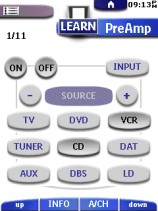|
...Continued from Page 6.
Learning from others.
As mentioned earlier, the Mode Menu is used to configure the remote. During normal operation the menu remains on the "Use" setting, but other modes such as "Learn", "Label", "Add", "Delete", "Move", "Brand" and "RF IR" are available. We've covered the "Brand" option - changing the preprogrammed device code - so let's now move on to "Learn" - teaching infrared signals to the remote.

Learning codes. |
Due to the ProntoPro's underlying architecture, extra panels of buttons cannot be added to a device on the remote. Instead, configurations must be designed with each and every panel the user could ever want already installed. While in "Learn" mode, all available panels for that device will be shown (during normal use, only panels that contain an "active" button will be displayed). To learn a command, just tap the button you'd like to teach and aim the source remote at the bottom of the ProntoPro, where the docking station connects. Hold the button down and, quite quickly, the remote will show it as being captured. Learning is straightforward and quick, with little delay between captured commands. In addition to normal function buttons, a learned signal can also be assigned to transmit each time a device is selected - but the PC software will allow you to do much more in this regard.
The hardware learning range of the ProntoPro remains the same as that of the TSU2000 - up to 56kHz. I would have expected to see a more advanced infrared sensor that handled up to at least 455kHz. As a compromise, the ProntoPro employs the same trick as used on the TSU2000 to coax the remote into capturing certain high-frequency or toggle-bit codes. This works, but requires Philips to have programmed the exact code already into the remote - new devices need not apply.
Although the ProntoPro employs no concept of "punch-throughs" for LCD buttons on the base remote (the PC software is a different case), it's a simple matter to merely learn what you want where you want. However, in the case of the 7 user-programmable hard buttons, the remote will automatically duplicate anything taught on the "Home" panel to all system devices. If a hard button is later taught under a specific device, the new code will override the system default but not affect other devices. This feature is especially useful for receiver volume commands, which would have posed an annoyance if they needed to be taught individually under each device.
When I began teaching the ProntoPro my components, I was surprised to experience an unusual amount of difficulty capturing signals. When the remote started rejecting codes before I sent them, the cause was clear. When users have difficulty capturing a code I generally recommend they follow our page of "learning tips and tricks", one of which requires turning off all lights in a room. Although it was the first time I've experienced this problem, the solution worked perfectly. Remembering that the same lamp and bulb has worked flawlessly with other remotes, I retested some and experienced the same trouble. Thus, the only reasonable explanation was that the bulb was wearing out and had started to radiate a greater amount of infrared. Once the bulb was changed, the ProntoPro learned flawlessly.
Philips has kept four infrared emitters on the ProntoPro - but instead of being clumped together in the middle of the remote, they are now spread out over the entire width of the new, larger infrared shield. Despite this change, infrared performance was identical to the TSU2000, earning a final grade of 3.0 on our MTFB (Menacing Thick Fluffy Blanket) infrared signal strength test - moderately good results.
| 
